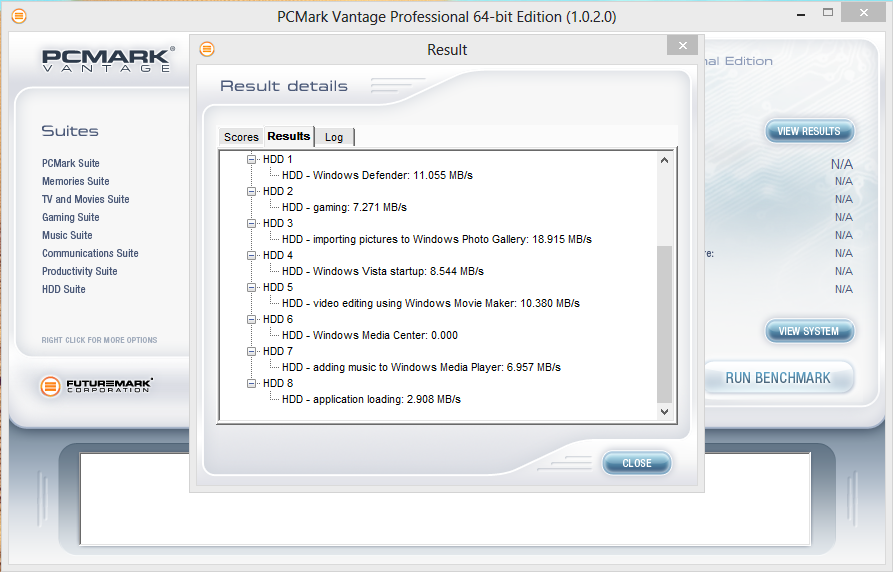VIAO T14 CACHING PERFORMANCE
After the first few days of use, the Sony VIAO T14 Touchscreen Ultra book seemed to hold its own and there was a significant difference between the start up, operation and shut down of the cached system compared to that of a normal HDD based laptop. We decided to run a few bench marks and that is where things changed. We felt as if we had been bluffed.
As we always do, our first test is PCMark Vantage and, as we can see here, a total score wasn’t even obtained as performance was so poor. This was confirmed in synthetic benchmarks such as ATTO Disk Benchmark:
This type of performance is indicative, and maybe even lower, than today’s hard drive alone. We have yet to see similar ever, admitting of course that packaged portable hybrid systems aren’t our forte, while the caching drives alone are. Rather amusing is the fact tat the minimum performance standard for Intel Specs is a transfer speed of 80MB/s so…it passed.
Crystal DiskMark high sequential performance confirmed that of ATTO and provided a bit more, displaying typical low 4k performance that one might see in a hard drive alone. As much as we wanted to believe that Condusiv ExpressCache was not working, the visible performance was significantly better than a hard drive alone.
UNDERSTANDING DISK ACCESS TIMES
Disk access time is the time it takes from when a piece of information is requested to when that information is returned and it differs significantly from a hard drive to an SSD. An understanding of how it works will provide reasoning as to how such bad performance was measured, yet excellent visible performance observed when using the Sony VIAO T14 for common tasks.
The access time of a hard drive is typically 9-10 ms and that of an SSD is now about .01-.02ms, some 45-100 times faster when calculated. Performance is logically not that much better but, suffice to say that an SSD is much faster at returning the information you requested. That is because an SSD has no moving parts and the information flows continuously like oil would in a pipeline. Actually, it is more like several pipelines as an SSD has several channels (or lanes) which allow simultaneous return of packets of information. Digital or electronic transmission provides for continuous data movement much like electricity.
The hard drive is, well, primitive in comparison and data movement is accomplished through mechanical movement. When information is requested, a magnetic arm moves across a magnetic disk, seeking the information while the disk spins at unbelievable speeds, 75mph if you are calculating this for the outside edge of a 7200 rpm hard drive.When it finds the information it needs, it retrieves as much as it can, sometimes mandating several returns for the remainder of the information. Consumer hard drives have but one mechanical arm so only one channel, or lane, of travel is available, vice 4, 8 or even 16 for the SSD.
This is why we observe considerably faster start up and faster typical operation when using the Sony T14 Ultrabook, a hybrid hard drive based system. This visible difference is accounted for primarily through disk access times. Such things as media manipulation would be affected by the low data transfer speeds seen above and we can confirm that this is the case with this system.
 The SSD Review The Worlds Dedicated SSD Education and Review Resource |
The SSD Review The Worlds Dedicated SSD Education and Review Resource | 


Hey there! Regarding NVelo on laptops – I’m pretty sure there was a Razer laptop that was delivered with NVelo Dataplex at some point. You might want to check that out! 🙂
Found it and you are absolutely correct, however, I was considering more aof a mainstream front such as we see with the Sony’s. Rereading the article, you are dead on though and Razer is the first. Will check into and possibly do up a review if I can get my hands on one.
Yeah :). Just thought i’d provide the info still. Thanks for looking into it!
Something i’ve been wondering about is the Expresscache vs Dataplex issue. Dataplex seems to be doing a better job so far, but i wonder how coming updates will affect that. It would be bad with no competition, so let’s hope in some time they will just have different perks, not different overall performance. And that they’ll start the “race” from there.
Les, at the end of your review you posted an update message. With regards to that message, how about doing a review of the various migration software programs that you have used, possibly adding that to the Guide section of your site. Migration software complaints run abundantly on Newegg and other forum sites.
Also, I would like to see a review of the Plextor mSata PX-M5M with the latest firmware.
What about the exmor hd webcam having poor quality?
I am sorry but that unit is no longer in our possession.